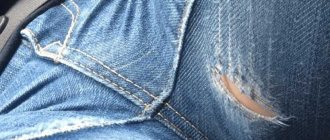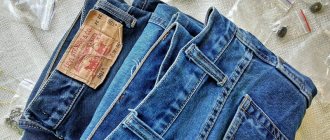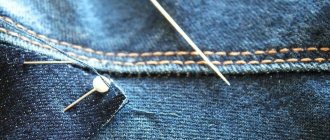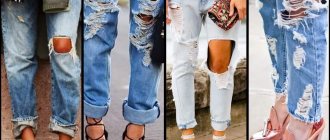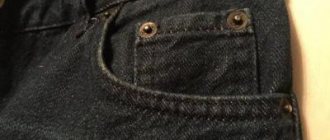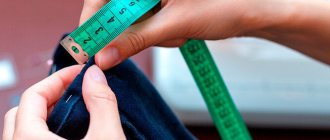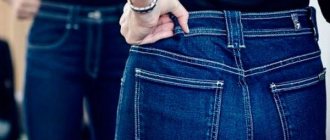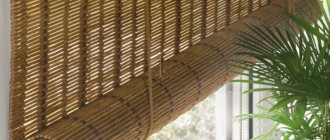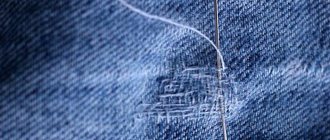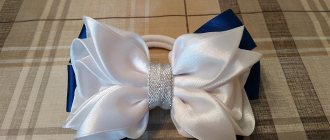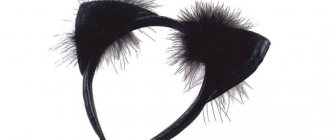Not a single child in the world is capable of carrying things neatly. But some children seem to be trying to set a world record for damaging T-shirts, jackets and, of course, pants. Even the most loyal parents in the world, who have a decent income and love to go to stores that sell children's clothing, at some point realize that they are already tired of “wasting on rags” and throwing away practically new things that have been worn at most four times, but at the same time hopelessly spoiled.
Asking your child to wear his clothes more carefully does not make sense, because the child does not deliberately spoil his things. There is only one way out - self-repair of clothes. Of course, not every item can be saved, but in some situations, sewing is quite capable of returning children's clothing to a presentable appearance. For example, if we are talking about holes in the trouser legs in the knee area, then throwing things away is out of the question; you need to take up a needle and thread.
Repairing children's things is not as boring as it might seem at first glance. On the contrary, in the process of returning clothes to a presentable appearance, it is quite possible to show your imagination and not only repair your pants, but also decorate them.
What material to use for the patch
A patch on jeans (fabric most often tears on the knee) not only hides the defect, it can be used as a finishing element. Denim trousers go well with different colors and textures. Depending on the model and purpose of the pair, a patch option is selected.
Fabric from jeans
Classic denim trousers can be combined with items of different shades and styles. To prevent the patch from standing out, it is cut out from the fabric of the trousers. It’s good if the fabric is preserved after shortening the pair.
The second option for a patch made from native fabric is the area under the back pocket. Any other fabric of similar density is sewn in place of the cut fabric.
Adhesive fabric
Minor damage and abrasions are fixed with adhesive material. Thick cotton adhesive with a dotted coating of adhesive is suitable.
For duplication, a part is prepared that is wider and longer than the damaged area. If you carefully make a patch from adhesive fabric, the work will be unnoticeable. It is not always necessary to hide traces of repairs.
Thermal patches
A patch on jeans on the knee or other part of the trousers, made in the form of embroidery, plays the role of finishing.
Embroidered pictures on fabric impregnated with textile glue on the reverse side are available in different colors and themes. On sale there are pictures from popular children's cartoons, army symbols, flowers, animals, birds.
The size of the thermal patch should be a couple of centimeters larger than the tear site. The damage is fixed with light stitches without tension. The trim is glued using a hot iron with steam for a few minutes.
Lace, colored, leather options
Depending on what type of clothing trousers are most often worn with, patches made from a material other than denim are selected.
| Pants model and denim color | Patch material and color | Top of the set |
| Blonde boyfriends; White jeans | White thick lace, white coarse mesh | White shirt or tank top |
| Black | Black lace, black leather | Biker jacket, white shirt |
| Blue Boyfriends; cropped jeans | Colored cell; black fabric | Biker jacket, white shirt |
| Blue slim mom cropped jeans | Floral fabric | Plain colored T-shirt; floral blouse |
| Blue; black | Fabric with sequins | Silk blouse, T-shirt with sequin appliqué |
The fabric with a pattern selected for the patch should not repeat the top of the set. It is enough for one color or shade to be common.
Machine embroidery, stripes
The proliferation of embroidery machines allows anyone to order embroidery on jeans according to their taste. After its completion, there will be no trace left of the damage that caused the transformation.
Machine embroidery is done with silk threads; the color and design can be chosen from those offered in the atelier. An alternative to machine embroidery can be a patch made from embroidery made on a different fabric.
DIY patch on jeans using a sewing machine
Most people have a good sewing machine in their home; having one allows you to independently repair your favorite pair of denim trousers. The more special operations the machine performs, the more interesting the result will be.
In addition to the sewing machine, for work you need to prepare:
- repair material;
- ruler and centimeter;
- threads of a color similar to the fabric of the trousers;
- sharp scissors for small jobs;
- cutting scissors;
- ripper;
- tailor's pins;
- adhesive fabric.
All preparation work is carried out on a table, in good lighting.
A thing doesn't age within a season
In other words, from television screens the idea is persistently introduced into the consciousness of the broad masses of the population that after a couple of years after purchase, every thing becomes unfashionable.
However, if some wealthy socialite can agree with this, then a practical woman in the street is not at all obliged, under the pressure of such dubious arguments, to refuse clothes that are still suitable for use.
All that is needed to return it to decent form is to eliminate the rupture or persistent contamination with your own hands.
True, modern women are so absorbed in working at the computer in the office and then at home that they have completely forgotten all those simple sewing techniques that their mothers and grandmothers regularly used.
How to do the thing
A patch on jeans (on the knee, between the legs, under the knee) is most often done using the plastering method. The method will hide abrasions and strengthen the fabric of nearby areas of the product.
It is performed in the following order:
- A patch of a similar configuration and larger size than the damaged area is cut out.
- Using an overlocker or a zigzag sewing machine, the edge of the patch is sewn.
- From the reverse side, using an adhesive web, the patch is glued to the duplicated area.
- The sewing machine is threaded with denim-colored threads.
- First, the stitching is done in the direction opposite to the position of the fabric hem. The distance between lines can be about 0.7 cm.
- The stitching in the direction of the hem of the denim closes the lines of the first operation and is performed much thicker - 0.3-0.2 cm.
- Depending on the degree of damage, the stitching can be more or less dense.
Properly executed gizmo is almost invisible and allows you to extend the life of the pair without changing the appearance.
Neat patch on elbows
You can restore damaged areas or old items with the help of a neat patch. This way the product will acquire an original appearance.
You can sew a neat patch on the elbows in the following way:
- you need to prepare everything you need;
- mark on the product where the patch will be applied;
- cut out the patches and sew them on.
Important! Once all the work is completed, the product needs to be steamed using an iron.
Neat patch on elbows
How to beautifully sew a tear in fabric or a seam on the knee
A patch on jeans on the knee of one leg or both is performed in the following sequence:
- The trouser leg in the knee area is the narrowest. For ease of work, the outer side seam, which does not have a finishing stitch, is ripped open from the bottom to the middle of the thigh.
- So that the patch does not interfere with the dynamics, the fabric is chosen to be loose, a little thinner than on the trousers. The shape of the patch can be any: square, oval or diamond.
- The patch is pinned to the knee of the jeans and adjusted using a sewing machine. The part allowance is cut off by 3 mm.
- Using a thick zigzag stitch, the patch is processed around the perimeter in such a way that the straight stitching line and the cut allowance are hidden.
Threads for finishing stitching are selected to match the tone of the fabric or a contrasting color.
How to sew decorative elements
Leisure clothing and children's jeans are often decorated with decorative stripes and embroidery. Damage to the fabric can also be covered with a colored patch; clothing design will only benefit from this.
Decorative elements can be sewn in different ways:
- by hand with neat small stitches;
- colored zigzag and straight stitch along the perimeter of the patch.
It will be good if the decorative stripes are matched in style with the existing ones. On trousers without stripes, you will have to create the design yourself. Some of the stripes will hide defects, while some will be sewn on only for decoration.
Jeans are easy to repair
For example, denim clothing torn during a walk in the forest or as a result of the pranks of pets can be safely mended or patched. Such basic repairs will save a lot of money for your personal budget and prevent your closet from becoming overcrowded with many identical items.
You can be convinced that modern technical means and materials make it possible to install simply magnificent patches on trousers of any style by quickly studying the numerous photos of patches for jeans published on the World Wide Web.
How to install an invisible patch
For an inconspicuous patch, select a fabric similar to the material of the trousers. The damage site is cut out in the shape of an oval or square. The patch follows the shape of the cut out part, but is larger by the amount of allowance. The direction of the warp thread on the trouser leg and the patch must match, so the result of the repair will be barely noticeable.
The blank is placed under the trouser part and adjusted with a straight stitch. The allowance is cut off by 0.3 cm and secured with a small zigzag. The closer the threads of the last line are in color to the material of the trousers, the more invisible the work will be.
How to do without a patch
A small damage that still has threads can be sewn up without using a patch. To secure the repaired area, an adhesive insert slightly larger than the wiped area is used. The duplicating fabric is glued from the inside out using a hot iron.
The front side is machined. Threads of stitching of a suitable color fasten the damaged area and the adhesive fabric; the thicker the zigzag of the stitching, the stronger the repair result will be.
The use of thermal drawing will help you do without a patch. First you need to make a stencil. The paint used is special, acrylic. As a result, a defect carefully fixed by any method (except for a patch) will be completely invisible thanks to the bright pattern. Turning your trousers into shorts will help you get by without a patch.
Idea three: patch from the inside out
Pants that look like they are made of several layers are very fashionable and beautiful. Such things are sold in boutiques and are very expensive. So why not repeat the design ideas and give trousers torn at the knees a super fashionable look?
To do this, you will need to sew a simple patch, but do it not on top of the hole, but from the inside out. The best option is to sew pieces of fabric over the entire knee area, from one side seam to the other. There is a difficulty in this method of mending clothes; you will have to sew very carefully so that the stitches are not noticeable on the front of the item.
"Dad is offended." Agata Muceniece about her relationship with Priluchny after the divorce
If there is little snow, there will be no harvest: December 16 is Ivan the Silent Day
A Brazilian travels 36 km by bike every day to take his loved one home.
Also, do not attach such a patch to the bottom. This will keep things looking neat when your child sits down, runs, or pedals a bike. If the lower part is fixed, then with any bend in the knees the trouser legs will begin to puff up.
How to beautifully hide damage to denim above the knee
Damage above the knee during movement has less impact on the comfort of the trousers. The patch in this part of the trouser leg can be made from any fabric. The requirements for strength and ergonomics are much lower than for a knee injury.
Beautiful options for this area:
- Lace fabric stitched on the reverse side. The beautiful finish can be repeated on another leg.
- Colored fabric with a pattern. A fabric patch with a checkered pattern looks stylish.
For a more dramatic look, the damaged area can be cut out much larger than the size of the damage. The edges can be ruffled; the same treatment is used on the bottom of denim trousers.
If the material breaks vertically, the defect can be turned into a pocket with a metal zipper:
- From a similar or finishing fabric, 2 strips of pocket blanks are cut into a frame.
- The cut on the trousers is fixed with adhesive on the reverse side.
- The pocket facings folded in half are adjusted “into a frame”.
- The pocket is cut and turned inside out.
- On the reverse side there is a zipper located in the center.
- The zipper is sewn on at the same time as the pocket burlap.
- The pocket burlap pieces are sewn together. The seam is overcast.
Patches for jeans in the form of pockets with zippers
You can make a patch pocket by first fixing the damage with adhesive and lightweight stuff.
Darning by hand
More skill and patience will be required for manual repairs.
For a hole in the shape of a rectangle, hand darning is used:
- A thread of a suitable color must be threaded into the needle twice.
- Having secured the thread on one side of the rectangular hole, you need to stretch it to the opposite side and secure it with one stitch.
- The thread is fixed again on the first side and so on until the entire “window” of the hand patch is filled.
- In the second direction, a needle and thread alternately interweaves threads in the opposite direction. The result is a dense mesh. It hides the defect and serves as finishing.
Socks were previously darned this way. The patches looked beautiful and spoke of the woman's skill.
How to darn with a hidden seam
A blind seam is used if it is necessary to sew up a hole in a product so that it becomes invisible. To do everything correctly, you should follow the recommendations:
- thread a needle and make a small knot;
- turn the product inside out;
- pass the needle inside out through the hole so that the knot remains there;
- sew up the hole;
- finish the seam.
After the hole is sewn up, you need to pull the thread until it goes into the seam and becomes completely invisible from the front side.
Blind seam
How to quickly close torn areas if there is no time
The process of darning jeans or sewing on a patch takes a long time or requires the use of a sewing machine. If you don’t have the time and the necessary equipment, you can decorate the damaged area on your knee with a sticker made of Swarovski crystals.
There are ready-made drawings on sale; they are the easiest to work with. It is enough to choose a drawing of a suitable theme and size. You can buy rhinestones coated with adhesive and make a design out of them yourself.
All work takes place in several steps:
- The damaged area is cut out. A patch of similar fabric is placed underneath.
- The edges of the lower part are glued with adhesive web or sewn around the perimeter.
- A pattern of rhinestones is laid out on the area to be covered. Cover with a piece of fabric and fix the temperature of the iron.
- The trousers are turned inside out and the area to be treated is carefully ironed from the wrong side.
Thermal patches are a kind of lifesaver when you don’t have enough time for lengthy repairs. The procedure for working with them is the same as with a pattern made of rhinestones. The quality of the repair depends on the mode of the iron and the time of its exposure. You can check the quality of gluing after the area being ironed has completely cooled.
Ideas for the most beautiful and stylish patches
Depending on the purpose of the denim trousers, the embroidery pattern and the type of patch material are selected.
For boys and girls
Children's clothing is bright; patches made from multi-colored pieces of durable fabric can be used to decorate it. All seams must be strong, there should be no protruding threads, fringes or buttons for decoration.
Patches on jeans for girls Patches on jeans for boys
A child will be delighted with an applique with embroidery in the form of a favorite cartoon character; it can be easily ordered from a studio or picked up a thermal sticker. Patches can also be designed in the shape of a heart, apple or animal.
For women
The modern fashion for ripped jeans leaves room for creativity when decorating trousers:
- iron-on embroidery stickers and rhinestone designs;
- patches made of lace and fabric with a pattern;
- drawing with acrylic paint using a stencil;
- applique made of colored fabric and leather.
The design style can also be varied, from a vamp woman to a romantic girl.
For men
The stronger half prefers stripes made of genuine leather. Damage to the knee can be covered with a genuine leather patch sewn into the side seams. The holes can be enlarged, the edges can be loosened, and the processing of many ready-made fashionable trousers can be repeated.
Decorated jeans have become a fashion trend in recent years. By sewing finishing fabric as a patch on the knee or hips, there is a chance not only to save your favorite pair, but also to improve their appearance. If the style should remain the same, an inconspicuous piece of work is done on the damaged area. Most defects in denim can be repaired and the pants can continue to be worn.
Article design: Natalie Podolskaya
Idea two: original shaped knee pads
The good thing about this repair method is that it can be used as a preventative measure. Indeed, why wait for a child to tear his trouser legs at the knees, if you can protect the thing and avoid a problem?
Knee pads can be made from old items that are ready for use in the home or are waiting to be thrown away. Of course, they can be given absolutely any shape. But it is necessary to proceed from where and how exactly the child usually tears his trousers at the knees. The shape of the sewn flaps should protect this particular place.
Women's jeans: before you buy them, you need to pay attention to one detail
The money tree pleases with lush flowering: my secret is in caring for the leaves
Why French children behave well: eight ways to raise them
For knee pads, you should take several layers of fabric, and it is advisable to use the most durable materials, for example, raincoat fabric or coat fabric. Of course, you need to sew them on with a beautiful decorative seam.
